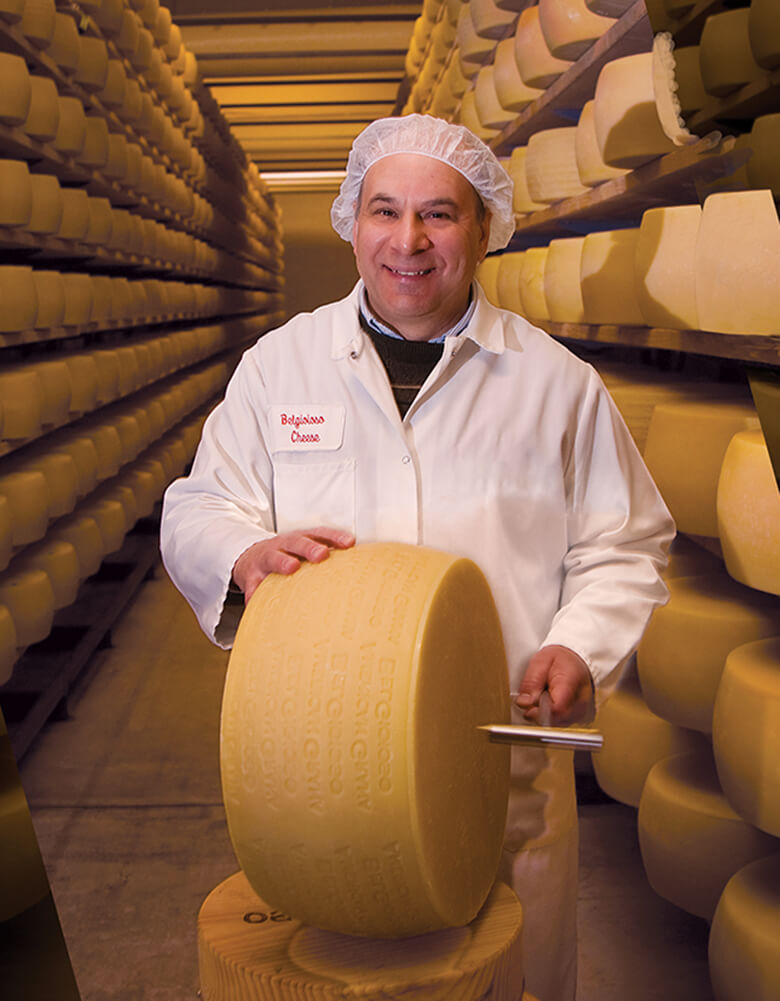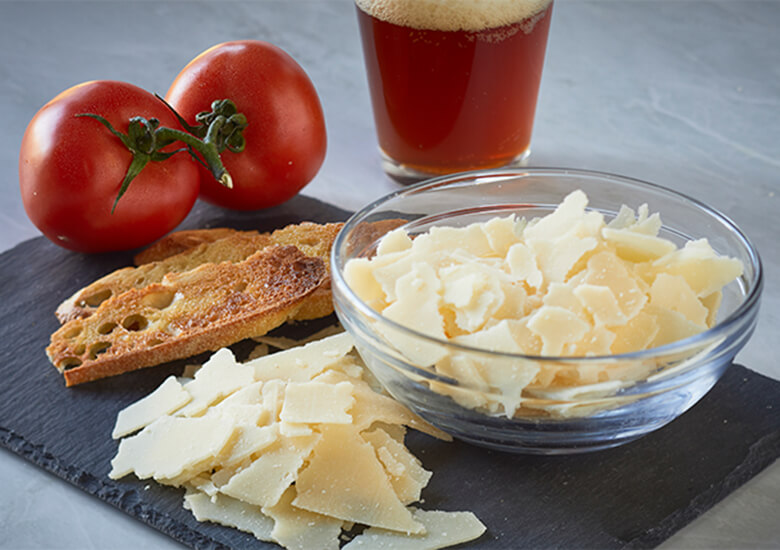It’s a cheese so good that many call it the “king of cheese,” and so valuable that banks have used it as collateral for loans. A simple cheese with a complex story, parmesan was born nearly a millennium ago in Italy before making its way to Wisconsin.
Despite its simplicity, parmesan can be a confusing cheese. After all, what’s really the difference between Italian Parmigiano Reggiano and Wisconsin parmesan? We’ll explain all of that and more in our guide to parmesan.
Cheese History: The story behind parmesan

Few cheeses have the kind of storied past that the legendary parmesan does. To really understand the significance of parmesan, we need to rewind nearly 900 years in time to Cistercian and Benedictine monasteries in northern Italy. Here, in the pastoral plains that make up the Italian provinces of Parma and Emilia Romagna, 12th-century monks created the cheese we recognize today as parmesan. Large herds of cattle paired with the abundant salt naturally occurring in the area resulted in a recipe for a cheese that became a much sought-after delight. Depicted in 14th-century art and a treasure Samuel Pepys's records in his famous 17th-century diary as one of the things he saved from the Great Fire of London, the French playwright and poet, Molière, is also said to have used it as a dietary supplement.
While many other cheeses have evolved significantly since their creation, written records dating back to the 13th and 14th century indicate that the parmesan we enjoy today is quite like the cheese that was produced hundreds of years ago. Nowadays, we distinguish traditional parmesan made in northern Italy with the name Parmigiano Reggiano.
All about parmesan cheese
There is so much to know about a storied cheese like parmesan, and it's hard to know where to begin. We've tackled a few of the key questions below.
What’s the difference between regular parmesan and Parmigiano Reggiano?
Great question! Parmigiano Reggiano cheese is called grana-style, which refers to the fact that during cheesemaking, the curd is cut super small—about the size of a grain of rice. This allows for more evaporation of the whey which in turn results in a firm, smooth, low moisture cheese that is ideal for grating. While Parmigiano Reggiano stays true to the origins of the legendary grana-style cheese, modern cheesemakers think outside the rind to create new and exciting cheeses under the broader parmesan name.
How is parmesan made?
Generally speaking, parmesan is made with cow’s milk that is first heated and then coagulated using rennet. The whey is separated from the curds before being packed into molds, where they are weighed and flipped to remove any remaining whey. After this, the wheels are soaked in a brine solution before moving to an aging cellar where they stay for 18-30 months—or even longer, depending on the variety.
What makes Wisconsin parmesan unique?

To understand how Wisconsin’s cheesemakers fit into the story of parmesan, we spoke with BelGioioso’s parmesan- and fontina-certified Master Cheesemaker, Gianni Toffolon. Toffolon worked alongside cheesemakers in northern Italy before coming to Wisconsin at the age of 23 in 1979. For Toffolon, it all started with a love for cheese.
“Cheese is a very, very important part of Italian culture and traditions,” says Toffolon.
This passion came into focus as he finished school and started working at a local cheese company as a seasonal holiday worker. Toffolon quickly fell in love with the cheesemaking process, staying on board even after the holidays passed.
When Toffolon was asked to move to Wisconsin to start making cheese, he immediately said yes. Just one week later, he was on a flight to America’s Dairyland. This rare combination of Old Word and New World experience is what makes Toffolon uniquely qualified to talk about how parmesan’s heritage fits into modern cheesemaking in Wisconsin.
When Toffolon started his journey in cheesemaking in northern Italy, there were already many strict production rules in place. Cheesemakers needed to work hard to find small ways to differentiate their parmesan.
“The milk is very important,” Toffolon explains. “The type of grass the cows eat, and the environment, change the microflora in the milk, which changes the cheese.”
In comparison to Italy, Toffolon notes that cheesemakers in Wisconsin had “the freedom to do whatever we want[ed]…and the freedom to find what worked here.” According to Toffolon, his approach to making parmesan in Wisconsin was less about recreating Italian Parmigiano Reggiano, and more about making something totally new and different.
This process wasn’t easy. For his take on parmesan, Toffolon had to carefully consider all the differences in the milk, starter culture, microflora, safety regulations, and more.
It’s a labor of love, he explains. “You make some mistakes but little by little you learn from them and eventually, you find the way.”
Toffolon is most proud of his work to create BelGioioso’s American Grana, which is heavily inspired by traditional Parmigiano Reggiano and took over four years of experimentation before the process was finalized. “The wheels of American grana are the same shape and size as Parmigiano Reggiano, and we age them exactly the way they do in Italy.”
Must-try Wisconsin Parmesan Cheeses
BelGioioso American Grana: Crafted by legendary Master Cheesemaker Gianni Toffolon, BelGioioso’s American Grana is a sterling example of what Wisconsin parmesan is all about. This cheese is made from fresh cow’s milk gathered every day from local farmers in America’s Dairyland. Each wheel is hand-turned and monitored to ensure the highest quality. The result? An award-winning cheese that combines the best of Italian tradition with Wisconsin ingenuity.
Sartori SarVecchio Parmesan: This mellow and fruity parmesan has won countless accolades– and with one bite, you’ll understand why. Made by one of Sartori’s Master Cheesemakers, Larry Steckbauer, SarVecchio represents 35 years of cheesemaking experience and passion. SarVecchio is delightfully crumbly and slightly crunchy, owed in part to the 20 months of aging that develops the crystalline texture that parmesan fans adore.
Cello Copper Kettle Parmesan: As the name suggests, Cello’s parmesan is made in small batches in traditional copper kettles before being aged for just over 16 months. This award-winning parmesan tastes rich, nutty, and slightly caramelly.
Pairing parmesan cheese

A classic cheese like parmesan can certainly stand on its own, but it is more than happy to share space and time with a few favorite beverages, too.
What beer goes well with parmesan cheese?
To mirror the nutty and rich flavor of parmesan, we recommend beers like Belgian ales or stouts—the darker the better. If you’re into something fruitier, a crisp and sweet hard cider can also pair well.
What wine pairs best with parmesan cheese?
When pairing wine with a serious cheese like parmesan, we turn to fruity, medium-bodied reds like Chianti, pinot noir, or even full-bodied options like a malbec or syrah. For white or sparkling wines, look no further than classic champagne, prosecco, or a riesling.
What spirits should I have with parmesan cheese?
If you’re pairing parmesan with a spirit, we recommend sweeter fare like sherry, grappa, nocino, and madeira. You also can’t go wrong with traditional hard-cheese pairings like scotch, bourbon, and brandy.
If you’re ready to take a deeper look into the world of cheese pairing, we recommend starting with our beginner’s guide to cheese pairing.
Ready to journey to the world of parmesan?
If all this talk of parmesan has gotten you hungry for a cheese tasting, you can get Wisconsin’s finest cheeses delivered right to your door with our continuously updated list of cheesemakers and retailers that allow you to order cheese online. Award-winning Wisconsin cheese is just a click away!
Craving something else? Choose from our selection of over 300 recipes featuring Wisconsin Cheese. Don’t forget to share your creative cheesy creations with us on Facebook and Instagram.
FAQs
Is parmesan cheese only made in Italy?
Parmesan can be made anywhere, but there are some caveats. The name Parmigiano Reggiano is protected and regulated, so only cheeses made in a specific area of northern Italy that adhere to a strict set of production guidelines may be called Parmigiano Reggiano. However, cheesemakers in the U.S. can use the name parmesan to refer to their cheeses. Think of Parmigiano Reggiano as a specific sub-category under the parmesan umbrella, like champagne and other sparkling wines.
How long does parmesan last?
If stored properly, parmesan can last over a month in your refrigerator. Make sure you’re using clean utensils to cut your parmesan and wrapping it in parchment paper to ensure it stays as tasty as possible. If your parmesan is already grated, it won’t last quite as long and should be used within 5-7 days. Whenever possible, grate your parmesan right before you use it for maximum freshness and flavor.
Why is parmesan cheese so good?
There are many factors that go into making parmesan such a perfect cheese. Compared to most cheeses, parmesan is very high in glutamate, which gives it a delicious sense of savoriness or umami that few other cheeses achieve. That’s why so many dishes grate parmesan on top—it’s basically a short cut to make nearly anything taste better.
Is parmesan cheese lactose-free?
Parmesan is almost entirely lactose-free. A typical serving of parmesan contains less than one gram of lactose, making it a delicious option for even lactose-intolerant cheese lovers!
